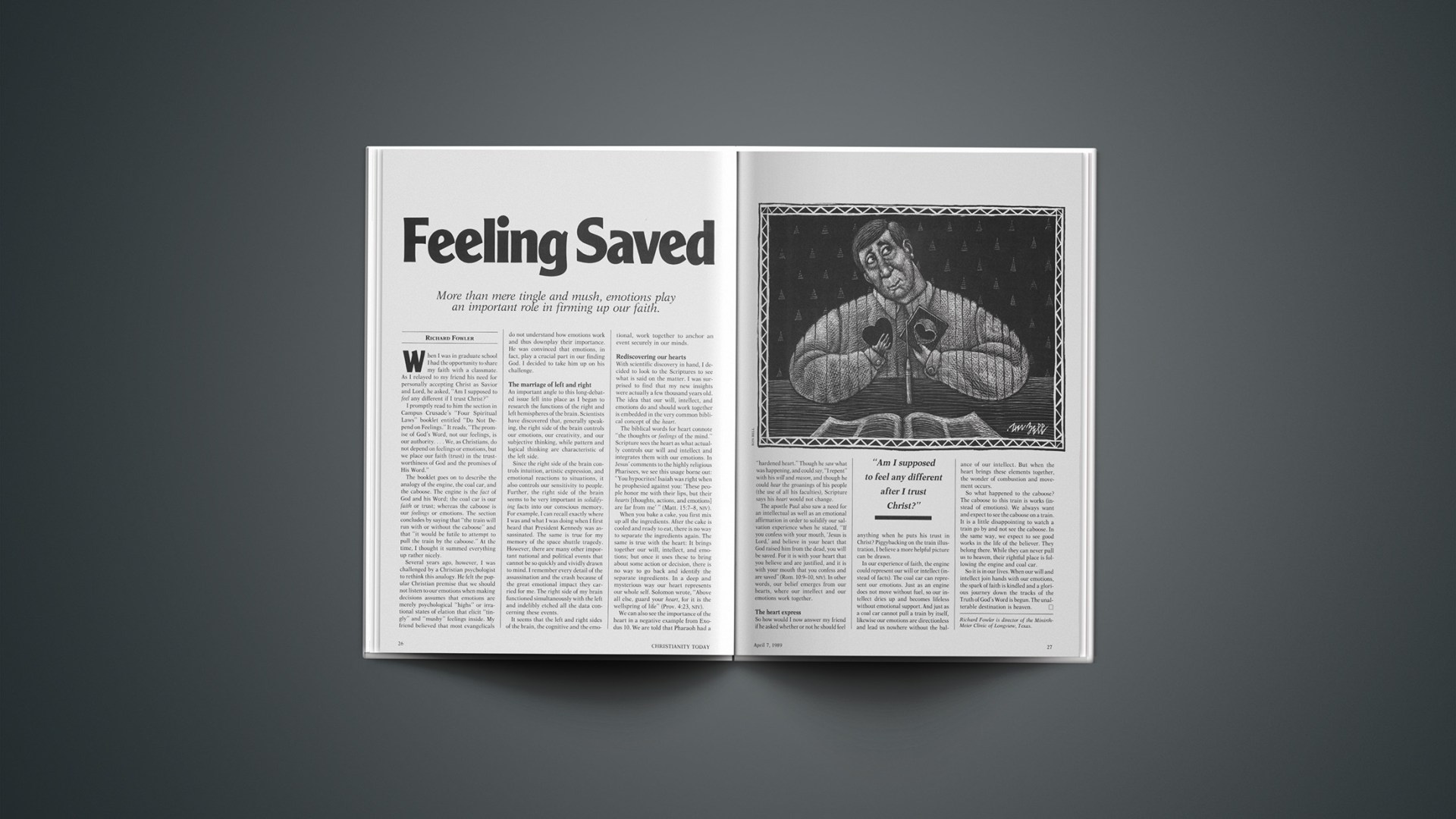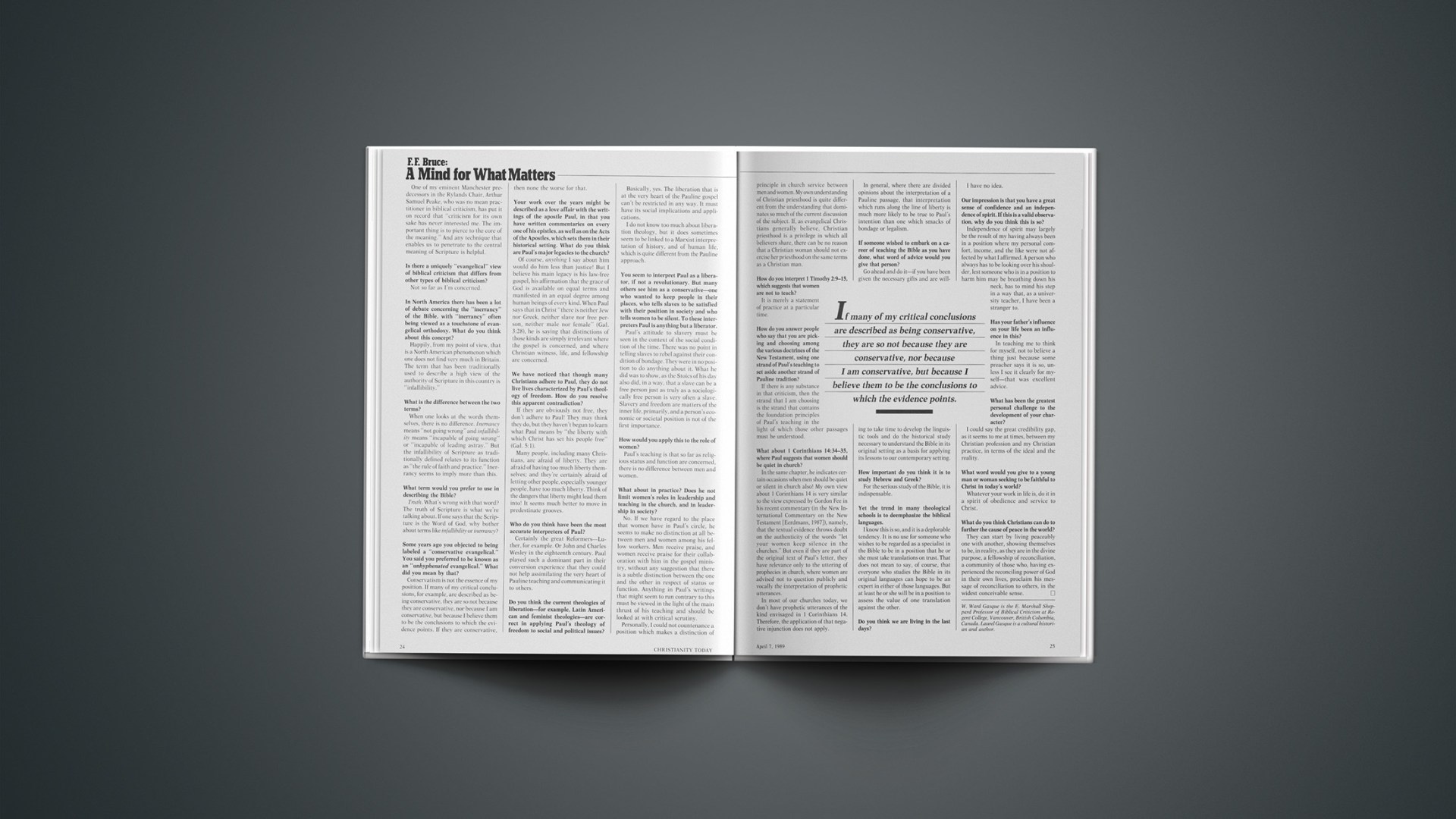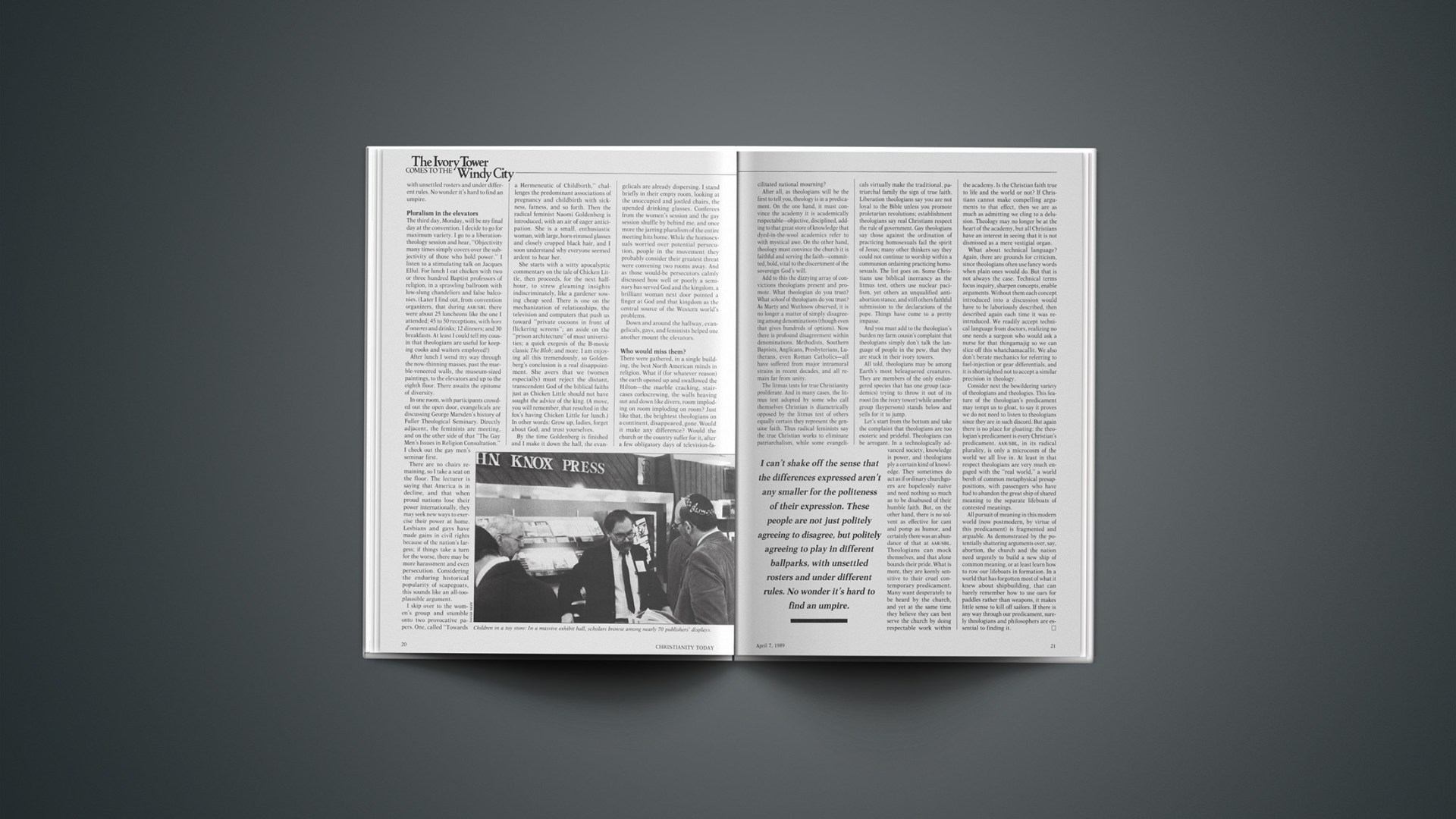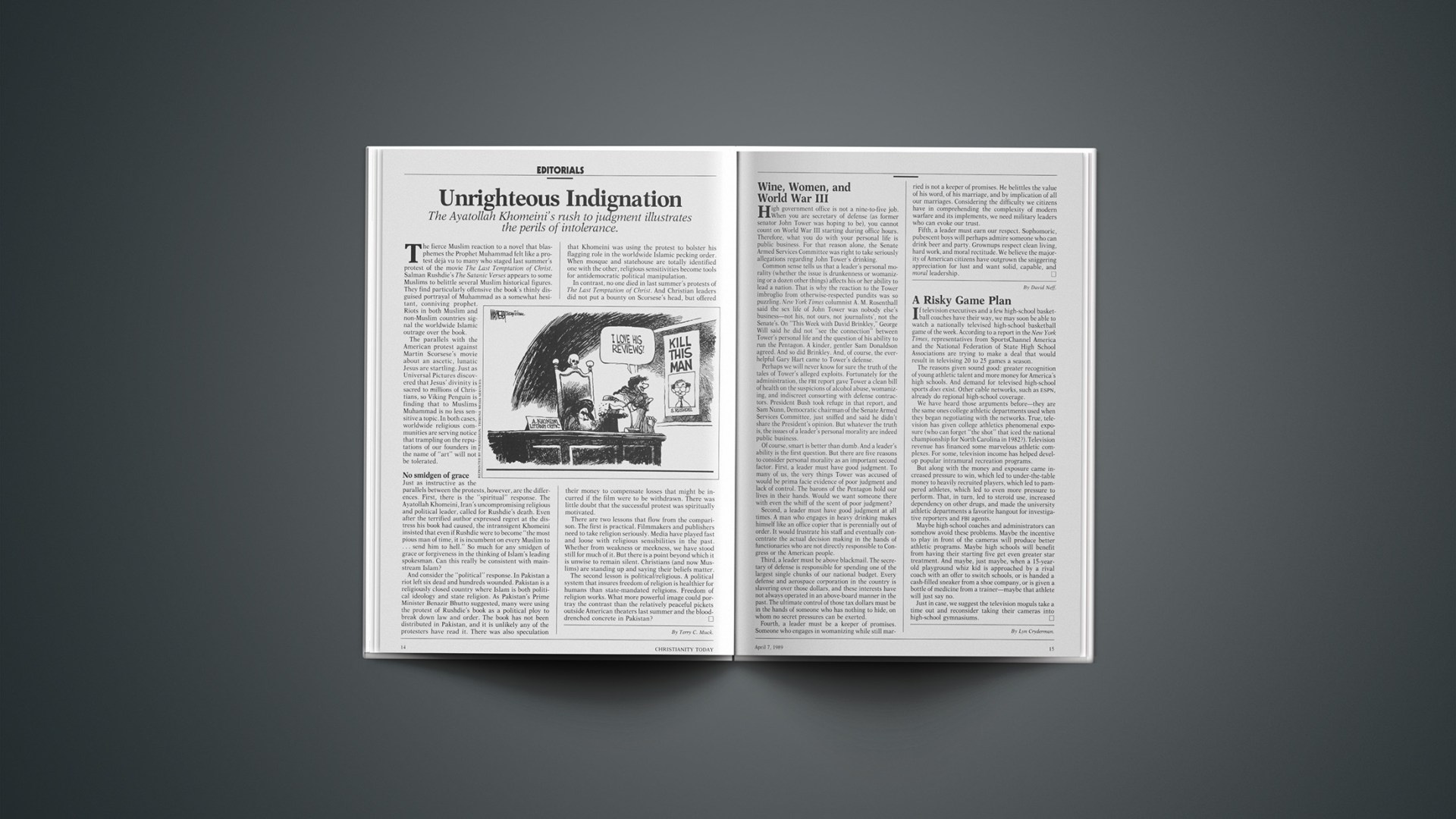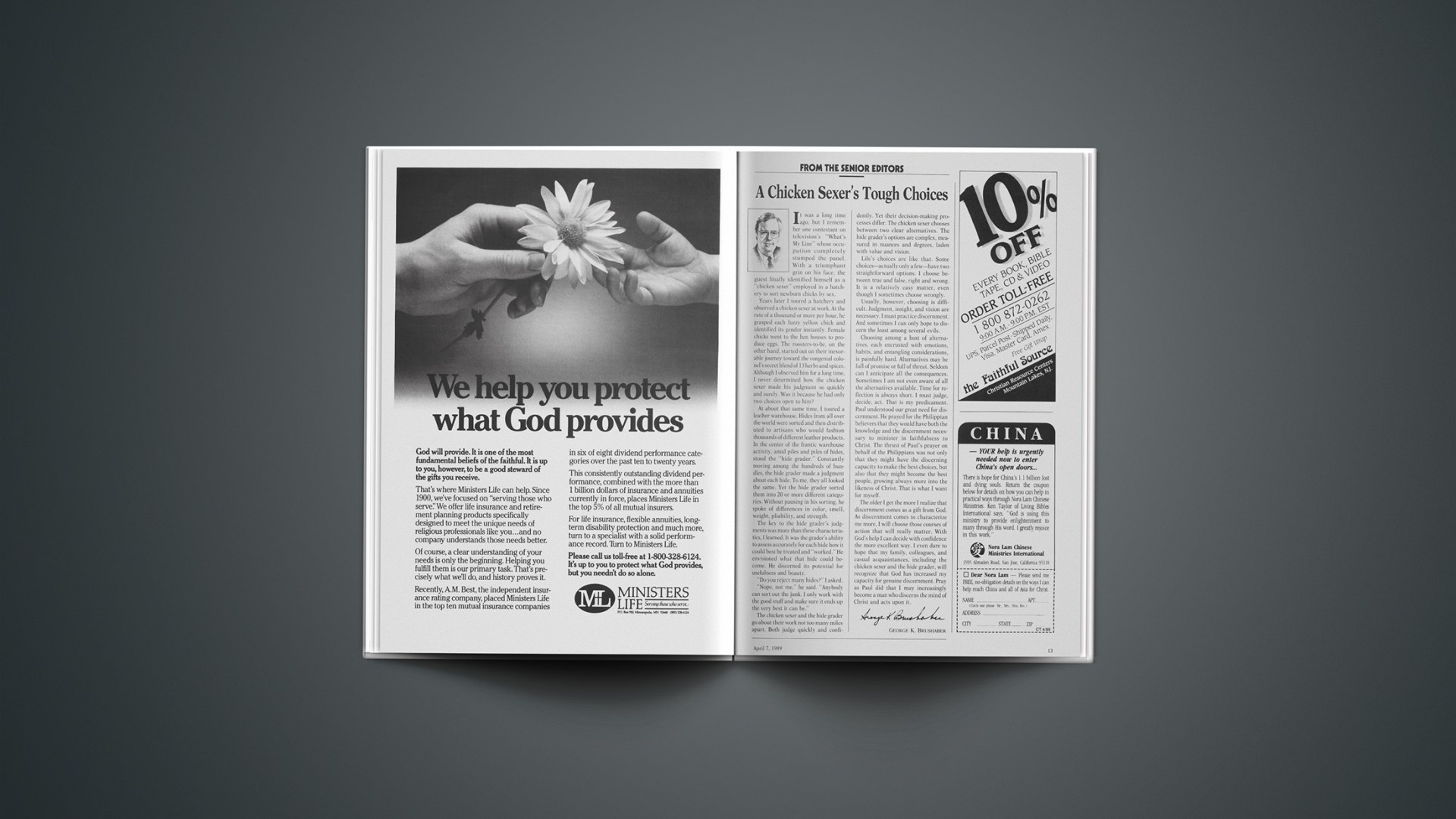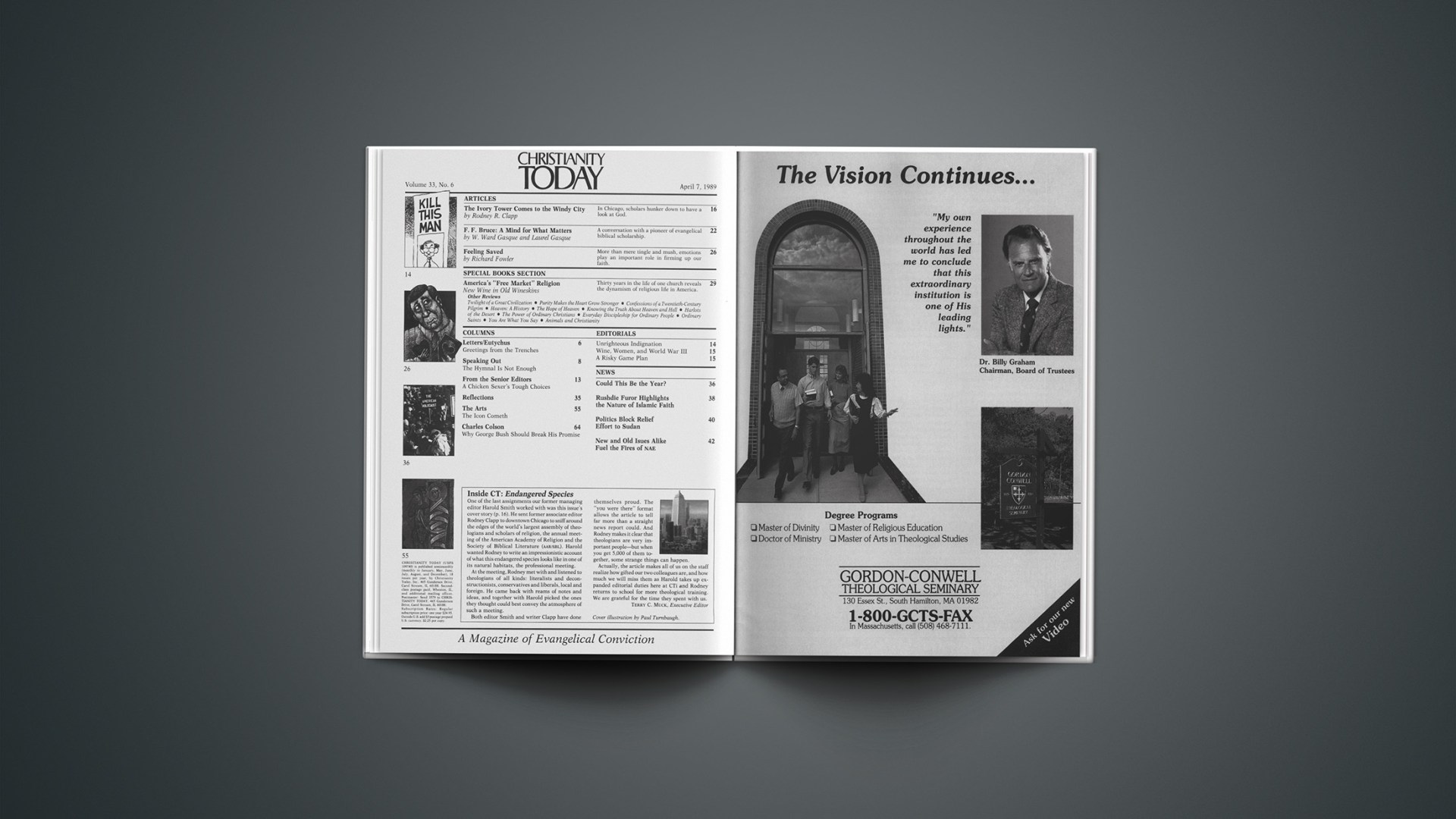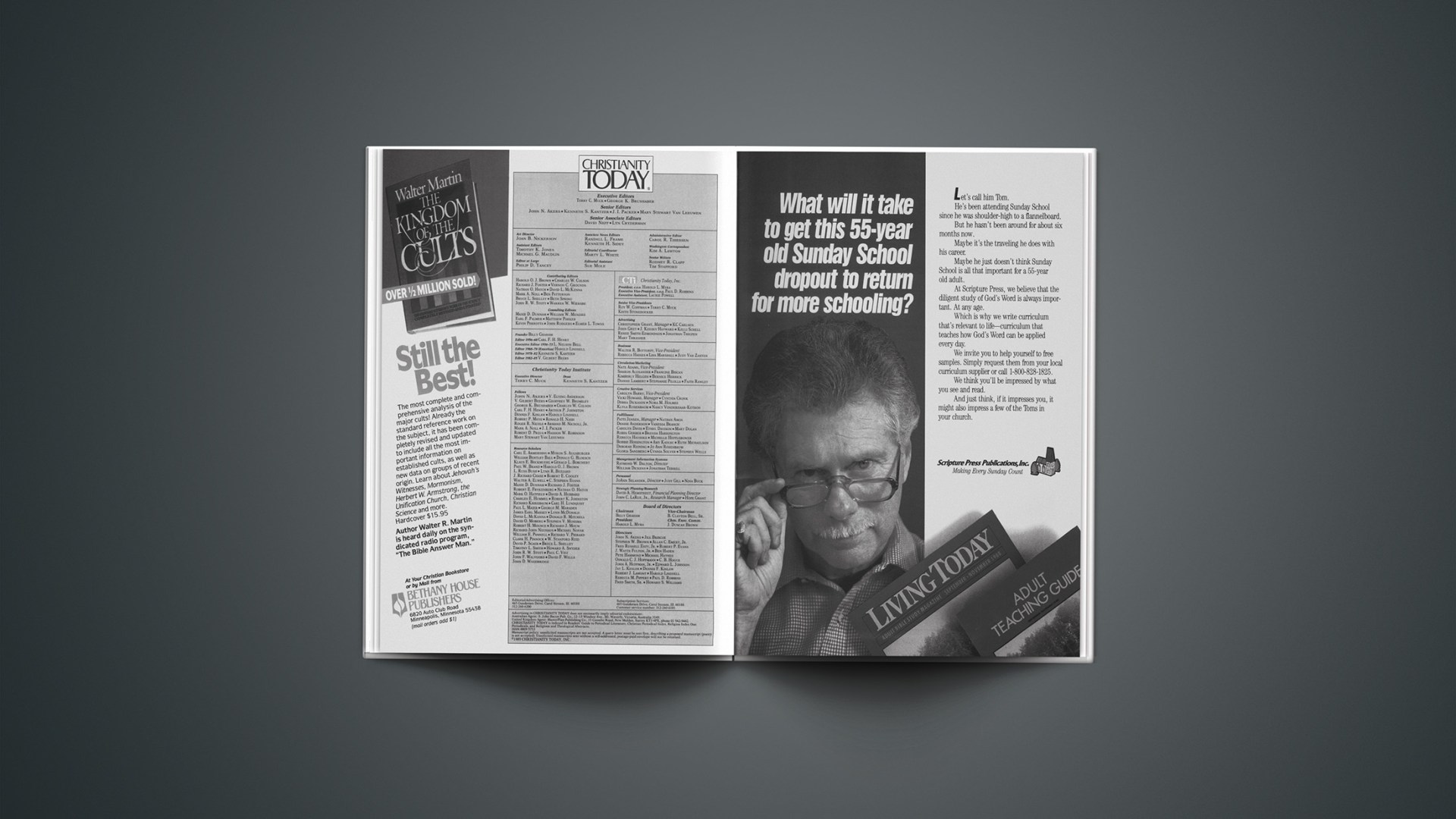New Wine in Old Wineskins: Evangelicals and Liberals in a Small-Town Church, by R. Stephen Warner (University of California Press, 355 pp.; $35.00, hardcover). Reviewed by Joel Carpenter, director of the Institute for the Study of American Evangelicals, Wheaton College, Wheaton, Illinois.
Why do evangelical churches seem to be particularly strong in America? What gives American religion its distinctive shape and dynamism? Is the evangelical resurgence a threat to American freedom?
R. Stephen Warner takes on these questions in his book New Wine in Old Wineskins. But he answers them in a unique way—by telling the story of one congregation, the Presbyterian Church in Mendocino, California, from the 1950s to the 1980s. Warner, a sociologist at the University of Illinois at Chicago, argues that even though this local Church’s history is unique, it typifies the American Protestant experience and so allows him to explore the changes in American religion and culture from the years of Eisenhower to those of Reagan.
Also reviewed in this section:
Twilight of a Great Civilization,by Carl F. H. Henry
Confessions of a Twentieth-Century Pilgrim,by Malcolm Muggeridge
Purity Makes the Heart Grow Stronger,by Julia Duin
Book Briefs:
Heaven: A History,by Pauline McDannell and Bernhard Lang
The Hope of Heaven,by Helen Oppenheimer
Knowing the Truth About Heaven and Hell,by Harry Blamires
Harlots of the Desert,by Benedicta Ward
The Power of Ordinary Christians,by Margaret Wold
Everyday Discipleship for Ordinary People,by Stuart Briscoe
Ordinary Saints,by Robert Benne
You Are What You Say,by Karen Burton Mains
Animals and Christianity,edited by Andrew Linzey and Tom Regan
Unlike most sociological studies, this book contains a sparkling, richly detailed narrative. We meet beatnik artists, a Chinese-American social-activist pastor, and communal hippies. And the church’s story is certainly not dry or static. A “faith ministry” to evangelize the hippies develops, a revival breaks out, and a charismatic fellowship emerges to energize Mendocino Presbyterian Church. The congregation calls a graduate of Fuller Theological Seminary, and in a decade its membership doubles.
Using this case study, Warner offers some insights about the recent evangelical resurgence. The strength of evangelical religion is partly a consequence of the voluntary, “free market” religious system in America, he asserts. The laity have had their way here, and they support churches that respond to their perceived needs and reflect their values. Evangelicalism gets the popular edge because its theology literally affirms the traditional beliefs and symbols of Christianity. Evangelicalism simply means what it says, and ordinary people can embrace, proclaim, and explain it with confidence.
Evangelicals’ intensely personal and parochial orientation, which liberals often disdain, also contributes to the movement’s strength. The Mendocino evangelicals made marriage and family the primary metaphors of their relationships: with Christ, the fellowship, and the community, as well as at home. Evangelicals’ embrace of marriage holds out a community ideal to our mobile and impersonal society, Warner explains, and is one reason for the group’s appeal.
Another community-building feature of evangelicalism is that it demands that people recognize their mutual dependence. This “culture of public humbling,” says Warner, opens the way for communal sharing and charity. Thus it is an open question, he argues, whether liberals’ focus on the “big issues” of public affairs promotes more human solidarity than evangelicals’ active caring for each other and their neighbors.
The author also doubts that evangelicals pose a threat to democratic institutions. While he grants that politicized fundamentalism has flexed some muscle and scared others with its theocratic rhetoric, he insists that evangelicals tend to make politics a low priority. More than anything else, Warner believes, evangelicals want respect. They have been angered and insulted by seeing the government lend support to beliefs and behavior of which they disapprove, but they want their values legitimated more than legislated. Evangelicals’ contribution to public discourse will most likely remain civil, since they have deep roots in American democratic traditions. Moreover, evangelicals want to live peaceably in the larger society; they want to please God and get along with their neighbors.
Finally, Warner argues that there are two sets of tensions at work in American Protestantism: the liberal-conservative division, and the conflicts between institutionalized, accommodating religion and innovative, “nascent” religion. The interaction of these two, he claims, provides a helpful grid for interpreting American Protestantism.
Though most people rarely, if ever, read sociological studies, here is one that a variety of readers should find useful. Besides sociology of religion courses, pastors and pastors-to-be of mainline congregations will find New Wine to be an extremely valuable case study of the promise and pitfalls of evangelical renewal. Pastors and lay leaders in evangelical denominations will find much to help them understand the larger religious scene. Liberal Protestants and secular academics will get a deeper understanding—and perhaps appreciation—of evangelicals. And evangelical laypeople will better understand the strengths and weaknesses of their own movement.
In sum, Warner’s book is a major achievement, and it deserves a wide readership.
A Prophetic Jeremiad
Twilight of a Great Civilization, by Carl F. H. Henry (Crossway, 192 pp.; $12.95, hardcover). Reviewed by Richard John Neuhaus, director of the Rockford Institute Center on Religion and Society, New York; his latest book is The Catholic Moment: The Paradox of the Church in the Postmodern World (Harper & Row).
At what he describes as “the unmellowed age of thirty-four” Carl Henry wrote The Uneasy Conscience of Modern Fundamentalism, and more than 40 years later the reverberations are still being felt. If by “mellowed” one means anything resembling complacency, a still unmellowed Carl Henry is at it again, as he has been indefatigably at it all these years. The “it” he is at is, first of all and last of all, the unembarrassed proclamation of God’s saving work in Christ. The acceptance of that gospel, however, must issue in myriad dimensions of discipleship. In the last of the 17 brief and spirited chapters of the present book, he looks back at Uneasy Conscience and allows that its focus on regeneration might have slighted the importance of government, law, and public reason in the responsible Christian life.
One of Henry’s favored words is cognitive, by which he means that the Christian must comprehend and contend for the truth claims of the faith. “Unless Christian scholars affirm the truth of Christianity in the context of public reason, rival religions will not respect its claim to universal truth or consider it worthy of a universal hearing,” he writes. In the light of that imperative, he is not much impressed by the vaunted achievements of “the evangelical renaissance.” In almost every chapter—whether the subject is evangelical colleges or the moral shoddiness of much money raising—Henry returns with unremitting urgency to the possibility that evangelicalism will miss, or has already missed, its historical moment of opportunity and obligation. There is naught here for the comfort of self-congratulatory Christians who regale one another with the success stories of evangelicalism’s having arrived.
“We need to do more than to sponsor a Christian sub-culture,” he declares. “We need a Christian counterculture that sets itself alongside the secular rivals and publishes openly the difference that belief in God and His Christ makes in the arena of thought and action.”
Even what he sees of the subculture is not all that inspiring. Far from it. Henry takes seriously the work of James Davison Hunter and others who have exposed troubling evidence that in the institutions of evangelicalism a veneer of Christian profession obscures a massive accommodation to a culture fundamentally at odds with biblical truth. At the same time, Henry will not ingratiate himself with sundry theocrats who propose that society be reconstructed on the basis of “Bible law.” With unyielding integrity, Carl Henry continues to insist that there is no substitute, either conceptually or in practice, for making the Christian case in a world that has not heard or does not understand or has knowingly turned against the truth. Were the term not so debased by overuse, one might say that Carl Henry is prophetic.
The jeremiad, or prolonged lamentation, is a vulnerable genre, though its power is demonstrated in more than one of these essays. It exacts a price, however, and at points Henry may paint with too broad a brush. He is too dismissive, for example, of Mark Ellingsen’s probings toward an evangelical-ecumenical rapprochement, and it is certainly not accurate to suggest that George Lindbeck’s proposal for theology in the “cultural-linguistic” mode is necessarily hostile to the question of objective truth. I would quibble, and at times more than quibble, over other arguments and asides. But in the space allotted the only honorable thing to do, the only honest thing to do, is to cheer the witness of a man who simply will not stop reminding us who we are called to be for a world that, beyond twilight, beyond midnight, is called to the risen Son.
Confessions of a Twentieth-Century Pilgrim, by Malcolm Muggeridge (Harper & Row, 150 pp.; $14.95, hardcover). Reviewed by K. L. Billingsley, the author of a forthcoming book on the National Council of Churches (The Ethics and Public Policy Center/University Press of America).
When Malcolm Muggeridge set out to write this book at age 84, a friend doubted whether, as a “halfblind scribbler,” he would be able to pull it off. Muggeridge not only did so, but turned in his usual extraordinary performance.
In his Confessions, Muggeridge writes about himself in the third person during different stages of life: the child, the adolescent, the journalist, the soldier. He likens his pilgrimage to that of Bunyan in Pilgrim’s Progress, or of Blake unraveling the Golden String that ends at heaven’s gate.
From the beginning, Muggeridge felt himself a stranger in this world. Particularly touching are the passages about his Bible, which he reads secretly, through all stages of life, in Egypt, India, and the USSR. In the Gospels he “discovered a new world,” and a depth found nowhere else. Later in his life, he notes that the most marked-up passages concern the Passion, and bear “stains that might be from tears.”
Unfortunately, like many of his fellows, he gets detoured into the blind alleys of the senses, what he calls the “death camp of carnality.” The pretext is the pursuit of happiness, but happiness, he writes at one point in his diary, “is like a young deer, fleet and beautiful.” But after the kill it becomes “a piece of stinking flesh.”
Then there are jousts with the liberal mind, which he sees as “systematically dismantling our Western way of life … dethroning God, undermining all its certainties.” Rejecting God, the liberal mind venerates science and power. The journalist is an eyewitness to the adulation of Stalin—a “class war Napoleon”—by the brightest lights of the West, including clergy. It was at this point that he rejected “earthly solutions.”
And here Muggeridge confirms the key role that his Soviet experience played in his pilgrimage. The Russian Christians with whom he worshiped expected nothing from their leaders, much less from the West. To God, then, they turned, and “[took] the Journalist with them.” He considers it strange that “I should have found myself nearest to You, Jesus, in the land where for half a century past the practice of the Christian religion has been most ruthlessly suppressed.”
On November 27, 1982, Muggeridge was received into the Roman Catholic Church, but he does not identify this as the time of his conversion. Some have speculated that it was a final way of thumbing his nose at Stalin and his fellow-traveling socialists. But here he explains that “it was the Catholic Church’s firm stand against contraception and abortion” that most influenced his decision.
As for embracing Christianity, this is “a question of faith, not of rational proof, but at the same time a reasonable faith. Provided one accepts the initial jump of the Incarnation, everything else follows.” Indeed, the Incarnation is central to Muggeridge’s faith. He dwells on what John Stott calls “basic Christianity” from which it is all too easy to stray, under the guise of “growth.”
Although the book covers some of the same ground found in his autobiographical works, here it is cast in a different context and from a different point of view. “For every situation and eventuality,” Muggeridge writes, “there is a parable if you look carefully enough.” Confessions of a Twentieth-Century Pilgrim is a parable for a confused and spiritually bankrupt age.
Purity Makes the Heart Grow Stronger: Sexuality and the Single Christian, by Julia Duin (Servant, 133 pp.; $6.95, paper). Reviewed by Janet Kobobel, book editor for Focus on the Family Publishing.
Society pressures singles to be sexually active. The church pretends sex doesn’t exist for singles. Single Christians are thus caught in the middle, not fitting comfortably in either world.
That is the thesis of Julia Duin’s book, Purity Makes the Heart Grow Stronger. A reporter for the Houston Chronicle and a single in her thirties, Duin argues that the church assumes abstinence is a condition of teens and college students to be cast aside when they marry. Unfortunately, a growing number of members in America’s congregations are in their twenties and thirties and so fall into the “abnormal” state of singleness. And most of them will remain unmarried, if not chaste, for their entire lives.
Purity is more than a diatribe against society and the church; it is a paean to the rewards of replacing sexual intimacy with intimacy with Christ. That song has been sung before in many books, but Duin brings to her work a refreshing insistence that singles are sexual beings even when they are celibate.
While Duin tells the reader that abstinence is not a vocation for the fainthearted, she advocates redirecting those energies rather than repressing them. “Unfulfilled sexual desires are such a source of pain that we often feel it is simpler to deny them altogether.… This can kill all tenderness in us. Instead of being submitted to Christ, who makes us face our pain, we choose the Law.”
She goes on to explain that a policy of refusing to touch others or to be open emotionally is a counterfeit way of handling sexual feelings. “Repressed people are lonely, driven, controlling, and [merely] functional,” Duin notes.
Throughout the book, she sprinkles tidbits of how she deals with her own sexual feelings, basically through diverting that energy into work, jogging, and church involvement. But she admits: “Then there are the times when all the hugs, activities, and cold showers can’t dispel our longings for sex. I take certain factors involved in sex, such as being vulnerable and surrendered, and express them in a nonsexual way.”
Duin suggests that the single who chooses chastity is like the woman who poured expensive perfume on Jesus’ feet—a lavish gift, a sacrificial gift, but an appropriate gift. It is an image that stirs and ennobles the heart of a single.
But then, Duin tells us, there are the shortsighted Esaus who sell their sexual birthright for a bowl of lentil stew. That is a poignant portrait no one wants to be identified with. But most singles know an Esau—and many have become Esaus.
Herein lies the book’s main problem. In the author’s rush to encourage the pouring out of the extravagant, fragrant oil, she fails to create an authentic picture of those who make other choices. She writes in blacks and whites. Sexual abstinence creates a satisfied celibate. Sexual expression results in promiscuity. One bite of this apple, and you’ll eat the whole orchard.
Such a limited and unrealistic depiction is especially disheartening when contrasted to Duin’s resonant call to face sexual feelings rather than repress them. At this point, she quickly slips from genuineness to a caricature of “fallen” celibates.
Neither does Duin deal adequately with older singles who date. She offers no clues as to how to develop an emotionally rich intimacy and yet maintain a physical relationship that is God-honoring. That is perhaps the hardest “vocation” of all.
Book Briefs
Mapping Heaven
Heaven is where everyone wants to end up, but few know what to expect once they get there. Several new books provide some helpful travel tips on that blessed place.
Heaven: A History, by Colleen McDannell and Bernhard Lang, is, according to its publisher, the first such history ever written (Yale, $29.95). It covers almost 3,000 years of both philosophical and popular reflections on that place of final rest. The first Christians said that there was no marriage, that bodies would be spiritual, and that there would be a heavenly liturgy. The Fathers of the church developed the notion of a glorified material world. Medievals promised a heavenly city. The Renaissance pointed to the pleasures of a paradisaical garden. And our coevals offer, among other things, a heaven on earth. There are lots of illustrations, from a drawing representing the universe as seen by the ancient Semites to Charles Anderson’s 1974 painting entitled The Rapture.
The preceding book asks the questions, What will an eternity in heaven be like? and, Whom are we likely to meet there? but the next book, The Hope of Heaven (Cowley Publications, $7.95), asks the question, What happens when we die? According to the author, Anglican Helen Oppenheimer, heaven is full of antinomies: play and maturity, body and spirit, love and fulfillment. And “the best images of Heaven are images of hospitality.”
A third celestial volume is Knowing the Truth About Heaven and Hell: Our Choices and Where They Lead Us (Servant, $7.95), by Harry Blamires. A pupil of C. S. Lewis’s and later his friend, Blamires is happily known for both fiction and nonfiction with a Christian cast. Like Lewis, he too treats heaven and hell as destinations. “The kingdom of Heaven is to be the focus of the Christian hopes and strivings.” Blamires’s book is one of a handily written, handsomely packaged series under the general editorship of J. I. Packer and Peter Kreeft. With it were also published Knowing the Truth About God’s Love, by Peter Kreeft, and Knowing the Truth About the Resurrection, by William L. Craig.
From unwholeness to holiness
Many Christians are familiar with the early Fathers of the church; some have heard of a few mothers of the church; but there were also, almost completely unknown to us, such women as Pelagia, Maria, Thais, and Mary of Egypt, who traversed the sandy, windswept road from prostitution to sanctity.
They and some others have been memorialized in Harlots of the Desert (Cistercian Publications, $29.95, hardcover; $11.95, paperback). The subtitle tells all: “A study of repentance in early monastic sources.” The translator and author is Benedicta Ward, an Anglican sister of the Love of God; she is also a patristics scholar, educating American college students at Saint Michael’s Hall, Oxford.
She writes, “I first thought of translating these texts after meeting Maria, a very young girl living in London as a prostitute. One evening she approached me and asked me to help her get away from a life she hated. While we talked, a car drove up, and Maria was taken away by her protectors. I dedicate this book to her, asking that the mercy of God may come upon us all.”
From ordinariness to extraordinariness
There is hope for the ordinary bloke, if there is any truth in a trio of recently published books.
Margaret Wold, who teaches at California Lutheran University, writes in The Power of Ordinary Christians: Witnessing in Jesus’ Name (Augsburg, $6.95) that God is “calling us ordinary Christians to be his witnesses to a new age for the church and the world.”
Stuart Briscoe, who pastors in Waukesha, Wisconsin, develops this theme in Everyday Discipleship for Ordinary People: Giving the Routine of Life the Glow of Heaven (Victor, $10.95). He begins with a red-haired, blue-eyed young woman who identified herself as “a disciple of Jesus Christ very skillfully disguised as a machine operator.” Whenever he thinks of her, he is reminded that ordinary folks make wonderful disciples. The rest of the book is about the ordinariness and indeed wonderfulness of this discipleship.
Robert Benne of Roanoke College has written an introduction to Christian life entitled Ordinary Saints (Fortress, $13.95). He confesses, “Teaching religion and ethics to college students, like facing a firing squad, concentrates the mind wonderfully.” These same students wanted “a straightforward and comprehensive account of the Christian life,” and this book is the result. Using a Lutheran lens, the author focuses on how ordinary people can know that “the extraordinary grace of God in Christ … is freely offered to them.”
Ingenuous and ingenious
You Are What You Say (Zondervan, $7.95) sounds like the headline in a supermarket tabloid; instead, it is the title of a book by Karen Burton Mains that offers a “cure for the troublesome tongue.” Its style is ingenuous, and its remedies are ingenious. It contains the sort of spirituality one might expect to find in the writings of one of the early mothers of the church. Probably no one else in the long and often-tedious history of Christian writing has treated the subject at such length and with such brightness as Mains. “There is power in the tongue,” she concludes, “power of life or death.”
Animals in the afterlife
Is Fido wagging his tail in heaven tonight? That depends on how much immortality there is in your theological universe. Expanding this universe somewhat are the 55 readings contained in Animals and Christianity (Crossroad, $16.95), edited by Andrew Linzey and Tom Regan. As these men look at it, the problem is somewhat larger than Fido’s wagging a tail in the afterlife. Rather, it has to do with such things as animal experimentation in this life, fur trapping, hunting for sport, intensive farming, and killing for food. Among the authors quoted at length in the book are Bonaventure and Karl Barth, C. S. Lewis and E. F. Schumacher, Paul Tillich and Leo Tolstoy.
By William Griffin, religious books editor for Publishers’ Weekly and the author of the recently released novel The Fleetwood Correspondence (Doubleday).

